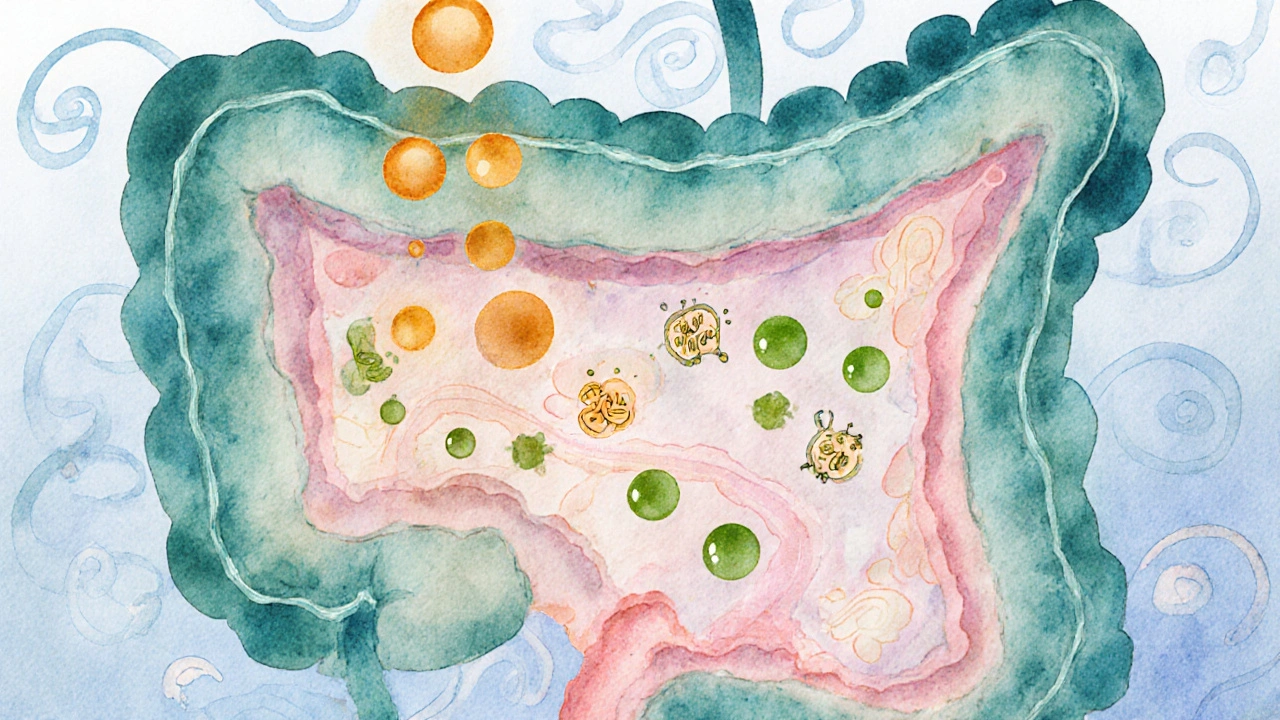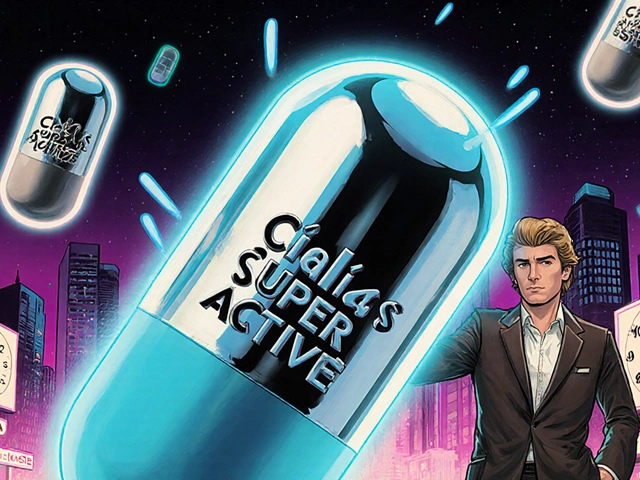Laxative Comparison Tool
| Product | Type | Onset (hours) | Duration (hours) | Cost (NZD/month) | Best For |
|---|---|---|---|---|---|
| Duphalac (Lactulose) | Osmotic | 24–48 | 24–72 | $20–$30 | Long-term, Liver Health |
| Milk of Magnesia (Mg(OH)₂) | Mineral Osmotic | 6–12 | 12–24 | $10–$15 | Quick Relief, Budget |
| Polyethylene glycol 3350 (MiraLAX) | Polymer Osmotic | 12–24 | 24–48 | $12–$18 | Long-term, General |
| Psyllium Husk | Fiber Bulk-forming | 12–18 | 24–48 | $8–$12 | Budget, Fiber Intake |
| Senna | Herbal Stimulant | 6–12 | 12–24 | $5–$10 | Quick Relief, Short-term |
| Bisacodyl | Stimulant | 6–12 | 12–24 | $7–$12 | Short-term Relief |
| Glycerin Suppository | Rectal Lubricant | 0.5–2 | 2–4 | $4–$8 | Emergency Relief |
Adjust filters to see personalized recommendations.
- For long-term use, osmotic laxatives like Duphalac are gentler than stimulants.
- Quick relief often comes from stimulants or rectal suppositories.
- Psyllium husk offers the lowest cost for ongoing treatment.
If you’re battling constipation, you’ve probably heard the name Duphalac comparison tossed around. But does it really beat the other options on the market? This guide breaks down Duphalac (lactulose) side‑by‑side with the most common alternatives, so you can decide which one fits your lifestyle, budget, and health needs.
What is Duphalac?
Duphalac is a brand‑name formulation of lactulose, a synthetic sugar that works as an osmotic laxative. It was first introduced in the 1960s and is prescribed for chronic constipation and hepatic encephalopathy. When you take Duphalac, lactulose isn’t absorbed in the small intestine; it reaches the colon unchanged, where gut bacteria break it down into acids that draw water into the bowel, softening stool and stimulating peristalsis.
How Lactulose Differs from Other Laxatives
Unlike stimulant laxatives that trigger bowel muscles directly, lactulose’s osmotic action is gentler and often preferred for long‑term use. It also has the added benefit of reducing ammonia levels in patients with liver disease. However, its sweet taste and the need for consistent dosing can be drawbacks for some users.

Popular Alternatives to Duphalac
- Magnesium hydroxide (commonly sold as Milk of Magnesia) - a mineral‑based osmotic laxative that neutralizes stomach acid while pulling water into the colon.
- Polyethylene glycol 3350 (known as MiraLAX) - a high‑molecular‑weight polymer that retains water in the stool without being absorbed.
- Psyllium husk - a soluble fiber supplement that expands when mixed with liquid, adding bulk and moisture to stool.
- Senna - an herbal stimulant that activates the colon’s muscle fibers, prompting quicker evacuation.
- Bisacodyl - a synthetic stimulant available in tablets or suppositories, often used for short‑term relief.
- Glycerin suppository - a rectal lubricant that softens stool locally, ideal for occasional constipation.
Side‑by‑Side Comparison
| Product | Type | Typical Dose | Onset (hours) | Duration (hours) | Common Side Effects | Estimated Cost (NZD/month) |
|---|---|---|---|---|---|---|
| Duphalac (Lactulose) | Osmotic | 15-30ml liquid or 5g powder daily | 24‑48 | 24‑72 | Bloating, gas, mild cramping | ≈$20‑$30 |
| Milk of Magnesia (Mg(OH)₂) | Mineral osmotic | 30‑60ml liquid every 4‑6h | 6‑12 | 12‑24 | Diarrhea, electrolyte imbalance | ≈$10‑$15 |
| Polyethylene glycol 3350 (MiraLAX) | Polymer osmotic | 17g (1 packet) dissolved daily | 12‑24 | 24‑48 | Flatulence, abdominal discomfort | ≈$12‑$18 |
| Psyllium husk | Fiber bulk‑forming | 5‑10g with 8oz liquid daily | 12‑18 | 24‑48 | Bloating, occasional blockage if not enough water | ≈$8‑$12 |
| Senna | Herbal stimulant | 0.5‑1mg tablet daily | 6‑12 | 12‑24 | Cramping, urgency | ≈$5‑$10 |
| Bisacodyl | Stimulant | 5‑10mg tablet at bedtime | 6‑12 | 12‑24 | Stomach pain, electrolyte loss | ≈$7‑$12 |
| Glycerin suppository | Rectal lubricant | 1suppository as needed | 0.5‑2 | 2‑4 | Local irritation, mild bleeding | ≈$4‑$8 |
Choosing the Right Option for You
Consider these three decision points when picking a laxative:
- Duration of use - If you need a chronic solution, an osmotic agent like Duphalac or PEG is usually gentler on the colon. Stimulants such as Senna or Bisacodyl are better suited for short‑term rescue.
- Speed of relief - For rapid action (under 4hours), glycerin suppositories or high‑dose magnesium hydroxide win. Duphalac’s slower onset makes it less ideal for emergencies.
- Health considerations - Patients with kidney disease should avoid magnesium‑based products, while those with liver impairment may benefit from lactulose’s ammonia‑lowering effect.
In practice, many clinicians start patients on a low‑dose osmotic (Duphalac or PEG) and add a fiber supplement like psyllium for added bulk. If the stool remains hard, a short course of a stimulant can break the stalemate.
Practical Tips for Safe Laxative Use
- Always drink plenty of water; osmotic agents pull fluid into the gut, and insufficient hydration can worsen constipation.
- Follow the exact dosing schedule - taking more than recommended rarely speeds up results and raises the risk of diarrhea.
- Monitor electrolytes if you use magnesium hydroxide or bisacodyl for longer than two weeks.
- Notify your GP if you experience severe abdominal pain, blood in stool, or no improvement after a week of therapy.
Frequently Asked Questions
Can I use Duphalac and a fiber supplement together?
Yes. Combining lactulose with a soluble fiber like psyllium can enhance stool softness while providing the bulk that some people miss from a pure osmotic laxative.
Is Duphalac safe for children?
Pediatric dosing is lower - typically 5ml of the liquid formulation twice daily for children aged 2‑12. Always check with a pediatrician before starting.
What if Duphalac makes me gassy?
Gas is a common early side effect. Starting with a half‑dose and slowly titrating up can ease the problem. Drinking warm water after each dose often helps.
Are there any drug interactions with lactulose?
Lactulose has few interactions, but it can affect the absorption of some oral antibiotics. Separate the doses by at least two hours to avoid reduced efficacy.
Which laxative is the cheapest for long‑term use?
Bulk‑forming fibers like psyllium often have the lowest monthly cost, followed closely by generic magnesium hydroxide. Duphalac is moderately priced, while branded PEG products sit in the mid‑range.
Bottom line: Duphalac shines when you need a gentle, long‑lasting solution, especially if liver health is a concern. For quick relief or lower cost, magnesium hydroxide, PEG, or fiber may be better fits. Use the comparison table and decision guide above to match the right laxative to your unique situation.






Manisha Deb Roy
October 9, 2025 AT 15:45Duphalac’s osmotic action makes it a solid long‑term pick; it's gentle on the colon and even helps lower ammonia for liver patients.
Just remember to keep hydratd so the water it pulls into the gut can do its job.
Helen Crowe
October 18, 2025 AT 21:58From a pharmacokinetic standpoint, lactulose’s non‑absorptive profile translates to a predictable osmotic gradient, which is why it’s a mainstay in hepatic encephalopathy regimens.
Anthony Aspeitia-Orozco
October 28, 2025 AT 04:11When you step back and view laxatives as a spectrum rather than isolated pills, a pattern emerges that can guide personal choice.
On one end you have gentle osmotic agents like Duphalac, which act by drawing water into the lumen without directly stimulating muscular contractions.
On the opposite end sit stimulant compounds such as senna and bisacodyl, which trigger the enteric nervous system to produce a rapid peristaltic wave.
The middle ground is occupied by polymer osmotics like PEG and mineral salts such as magnesium hydroxide, offering a balance between speed and tolerance.
Each category carries its own risk‑benefit profile, shaped by onset time, duration, side‑effect spectrum, and cost.
Duphalac’s onset of 24‑48 hours makes it unsuitable for acute constipation crises, but its consistency shines in chronic management, especially when hepatic considerations are present.
PEG, with a 12‑24 hour onset, fills the niche where patients desire a quicker effect without the cramping that stimulants often provoke.
Magnesium hydroxide provides the fastest relief among osmotics, yet prolonged use can skew electrolyte balance, a critical factor for patients with renal insufficiency.
Fiber supplements like psyllium add bulk and improve stool form, and they are the most economical long‑term option, though they require adequate fluid intake to avoid obstruction.
Stimulants, while effective within 6‑12 hours, carry the danger of melanosis coli and can diminish colonic responsiveness if overused.
Rectal lubricants such as glycerin suppositories act in minutes, but their utility is limited to occasional rescue rather than maintenance.
Cost considerations also play a role: generic psyllium often costs under $10 NZD per month, whereas branded Duphalac sits around $20‑$30, reflecting the added value of its liver‑supporting properties.
In practice, clinicians frequently initiate therapy with a low‑dose osmotic, monitor tolerance, and supplement with fiber; if stools remain hard, a short course of a stimulant can be introduced as a “breakthrough” agent.
Patient education on hydration cannot be overstated; osmotic agents will only work efficiently when there is water to draw into the colon.
Finally, regular follow‑up to assess symptom relief, side effects, and any changes in laboratory parameters ensures therapy remains safe and effective.
Adam Dicker
November 6, 2025 AT 10:25If you need relief fast, don’t waste time with a slow‑acting osmotic-grab a glycerin suppository or a dose of magnesium hydroxide and feel the difference within a couple of hours.
For chronic cases, stick with Duphalac or PEG, but remember they’re a marathon, not a sprint.
Molly Beardall
November 15, 2025 AT 16:38Honestly, the hype around Duphalac is overblown; sure, it’s gentle, but the gas and bloating can turn your day into a nightmare-especially if you’re not ready to drink extra water.
And let’s not forget the price tag-why pay $30 a month when a bag of psyllium does the trick for pennies?
Brian Pellot
November 24, 2025 AT 22:51Good point on hydration – I always keep a bottle at my desk.
Patrick McCarthy
December 4, 2025 AT 05:05Hydration is key, and pairing lactulose with a modest amount of fiber can smooth out the gas issue while still giving you the liver benefits.